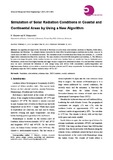Simulation of solar radiation conditions in coastal and continental areas by using a new algorithm

View/
Date
2011Author
Monowe, P.
Nijegorodov, N.
Publisher
David Publishing Company, http://www.davidpublishing.com/journals_info.asp?jId=1000Type
Published ArticleMetadata
Show full item recordAbstract
An algorithm developed at the University of Botswana is used to study solar radiation conditions in Namibia, South Africa, Mozambique and Botswana. The synoptic stations chosen for the study differ by meteorological conditions and location: some are in coastal areas and others are in continental locations. The simulation results reveal that daily direct beam solar radiation, Hbn, is usually higher in the continental area than in the coastal one. The same situation is observed with daily global solar radiation, Hg. The difference becomes even larger for partly cloudy weather, because in coastal areas sunshine hours are usually less than in continental areas. Furthermore, coastal areas have higher humidity and bigger air mass compared to continental locations. It is concluded that continental areas are more convenient for utilisation of solar energy using solar devices with concentrators (middle-temperature and high-temperature Rankine cycles), while at coastal areas flat-plate collectors and PV-arrays are preferable. It is found out that the range of optimum slopes for SADC countries studied is from +30° to -62°
